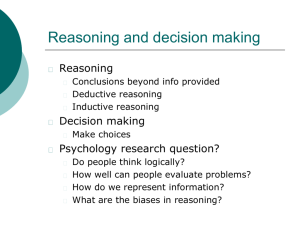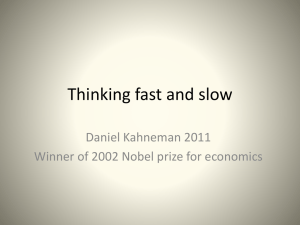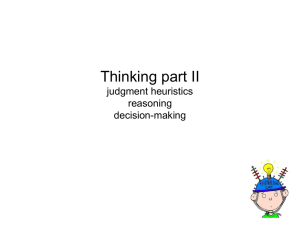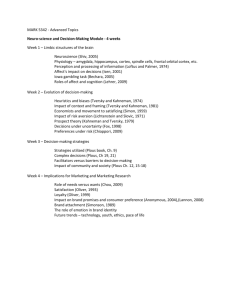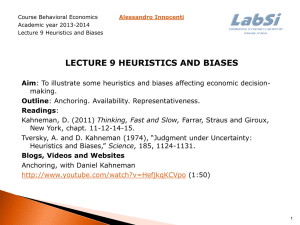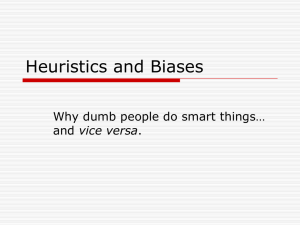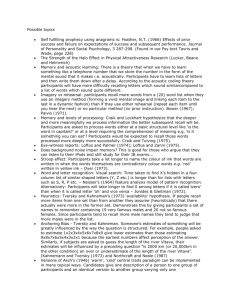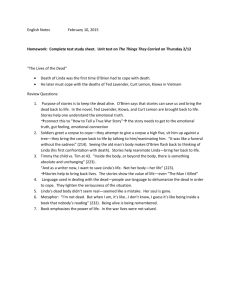Review of Daniel Kahneman, Thinking Fast and Slow
advertisement
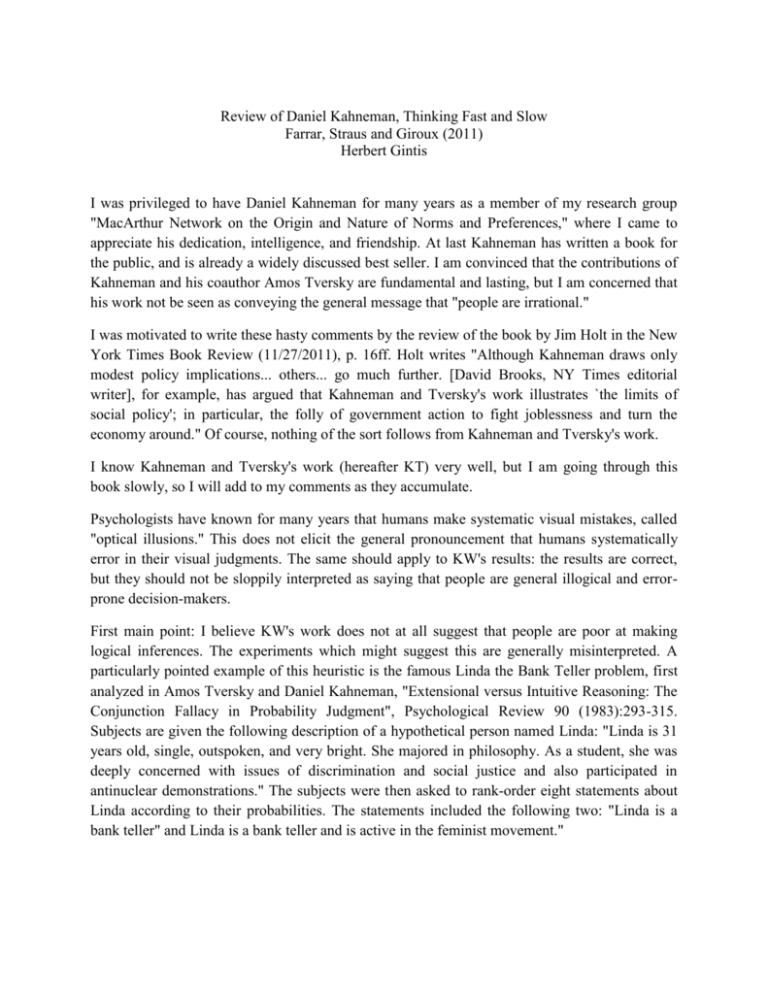
Review of Daniel Kahneman, Thinking Fast and Slow Farrar, Straus and Giroux (2011) Herbert Gintis I was privileged to have Daniel Kahneman for many years as a member of my research group "MacArthur Network on the Origin and Nature of Norms and Preferences," where I came to appreciate his dedication, intelligence, and friendship. At last Kahneman has written a book for the public, and is already a widely discussed best seller. I am convinced that the contributions of Kahneman and his coauthor Amos Tversky are fundamental and lasting, but I am concerned that his work not be seen as conveying the general message that "people are irrational." I was motivated to write these hasty comments by the review of the book by Jim Holt in the New York Times Book Review (11/27/2011), p. 16ff. Holt writes "Although Kahneman draws only modest policy implications... others... go much further. [David Brooks, NY Times editorial writer], for example, has argued that Kahneman and Tversky's work illustrates `the limits of social policy'; in particular, the folly of government action to fight joblessness and turn the economy around." Of course, nothing of the sort follows from Kahneman and Tversky's work. I know Kahneman and Tversky's work (hereafter KT) very well, but I am going through this book slowly, so I will add to my comments as they accumulate. Psychologists have known for many years that humans make systematic visual mistakes, called "optical illusions." This does not elicit the general pronouncement that humans systematically error in their visual judgments. The same should apply to KW's results: the results are correct, but they should not be sloppily interpreted as saying that people are general illogical and errorprone decision-makers. First main point: I believe KW's work does not at all suggest that people are poor at making logical inferences. The experiments which might suggest this are generally misinterpreted. A particularly pointed example of this heuristic is the famous Linda the Bank Teller problem, first analyzed in Amos Tversky and Daniel Kahneman, "Extensional versus Intuitive Reasoning: The Conjunction Fallacy in Probability Judgment", Psychological Review 90 (1983):293-315. Subjects are given the following description of a hypothetical person named Linda: "Linda is 31 years old, single, outspoken, and very bright. She majored in philosophy. As a student, she was deeply concerned with issues of discrimination and social justice and also participated in antinuclear demonstrations." The subjects were then asked to rank-order eight statements about Linda according to their probabilities. The statements included the following two: "Linda is a bank teller" and Linda is a bank teller and is active in the feminist movement." More than 80\% of the subjects---graduate and medical school students with statistical training and doctoral students in the decision science program at Stanford University's business school--ranked the second statement as more probable than the first. This seems like a simple logical error because every bank teller feminist is also a bank teller. However, there is another interpretation according to which the subjects are correct in their judgments. Let p and q be properties that every member of a population either has or does not have. The standard definition of "the probability that member x is p" is the fraction of the population for which p is true. But an equally reasonable definition is the probability that x is a member of a random sample of the subset of the population for which p is true.' According to the standard definition, the probability of p and q cannot be greater than the probability of p. But, according to the second, the opposite inequality can hold: x might be more likely to appear in a random sample of individuals who are both p and q than in a random sample of the same size of individuals who are p. In other words, the probability that a randomly chosen bank teller is Linda is probably much lower than the probability that a randomly chosen feminist bank teller is Linda. Another way of expressing this point is that the probability that a randomly chosen member of the set "is a feminist bank teller" may be Linda is greater than the probability that a randomly chosen member of the set "is a bank teller," is Linda. I believe my interpretation is by far the more natural. Moreover, why would the experimenters have included information about Linda's college behavior unless it were relevant? This behavior is completely irrelevant given KW's interpretation of probability, but wholly pertinent given a "conditional probability" interpretation. The latter can be colloquially restated as "the conditional probability that an individual is Linda given that she is a feminist bank teller is higher than the conditional probability that an individual is Linda given that she is a bank teller." Second Main Point: Many of the examples of irrationality given by KW are not in any way irrational. Consider for example the chief investment officer described by Kahneman (p. 12). This man invested tens of millions of dollars in Ford Motor Company stock after having visited and automobile show and having been impressed with the quality of the current offering of Ford vehicles. Kahneman says "I found it remarkable that he had apparently not considered the one question that an economist would call relevant: I Ford stock currently underpriced?" In fact, there is no objective measure of a stock being "underpriced," and no known correlation between a measure of "being underpriced" and subsequent performance on the stock market. Moreover, the executive may not have revealed all of the reasoning involved in his decision, but rather only a "deciding factor" after other considerations had been factored in. Third Main Point: We have long known that people do not generally act in their own best interest. We have weakness of will, we procrastinate, we punish ourselves for things that are not our fault, we act thoughtlessly and regret our actions, yet repeat them, we become addicted to cigarettes and drugs, we become obese even though we would like to be thin, we pay billions of dollars for self-help books that almost never work. KW have not added much, if anything, to our understanding of this array of bizarre behaviors. Of course, they do not claim otherwise. However, commentators regularly claim that this behavior somehow contradicts the `rational actor model' of economic theory, which it does not in any way. Economic theory explores the implications of human choice behavior without claiming that the choices people make are in some sense prudent or even desirable to the decision-maker (we cannot choose our preferences). Economic theory is in general supportive of the notion that people should get what they want, but has included the notion of "merit goods" that society values or disvalues for moral or practical reasons that counterindicate consumer sovereignty. For instance, we regulate pharmaceuticals, we prohibit racial discrimination in public places, and we outlaw markets in body parts. Fourth Main Point: KW are right on target in asserting that people make massive errors in interpreting statistical arguments (e.g., the base rate fallacy, or the interpretation of conditional probabilities). This has nothing to do with "illogicality" or "irrationality," but rather the complexity of the mathematics itself. For instance, KW have shown that physicians routinely fail to understand what the statistical accuracy of lab tests mean---the fact that at test is 95% accurate is compatible with the fact that it is wrong 95% (or any other, depending on the incidence of the condition that is test for) of the time. The psychologist Gerd Gigerenzer has shown that if conditional probabilities are reinterpreted as frequencies, people have no problem in interpreting their meaning (see the discussion "Risk School" in Nature 461,29, October 2009). Gigerenzer has be promoting the idea that trigonometry be dropped from the high school math sequence (no one uses it except surveyors, physicists, and engineers) and probability theory be added. This sounds like a great idea to me. Of course, if people do not do well a formal statistical analysis, how are to we defend the rational actor model, which is thoroughly Bayesian and implicitly assumes people are infinitely capable statistical decision-makers? The answer is not to abandon the rational actor model, which in general has had exceptional explanatory power---see my book, The Bounds of Reason (Princeton 2009) and my review of Ken Binmore's Rational Decisions (Economic Journal, February 2010). Rather, I believe the answer lies in replacing the subjective prior assumption of the rational actor model with a broader assumption that individuals make decision within networks of minds that are characterized by distributed cognition, much as social insects, except of course on a much higher level, using language instead of pheromones, with the cultural construction of iconic rather than pheromonic signals. But, that is the subject to be explored in the future. One of the payoffs of KT research is to make it clear how insufficient the standard economic model of decision-making under (radical) uncertainty really is.


